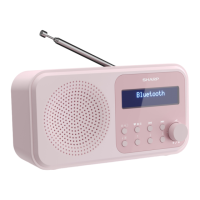EN
• Signal strength - An empty will appear on the
display to indicate the minimum signal strength
for acceptable listening. The row of solid rectangles
indicates the actual signal strength that you are
receiving.
• Program type (PTY) – e.g., ‘Rock’, ‘Pop’, ‘Talk’ or ‘News’
• Multiplex name - Displays the broadcasting area
and collection of radio stations on this frequency
e.g., BBC National DAB, Digital 1 Network
• Channel and frequency – e.g. 12B 225.648 MHz
(Channel=12B, Frequency=225.648 MHz)
• Signal error - This is displayed as a number between
0-99. To satisfactorily listen to a radio station, the
signal error must be below 30. Adjust the aerial or
relocate your radio to improve reception.
• Signal information - The data rate at which the
signal is being transmitted.
• Power indicator – displays <USB Power> when
powered by USB; displays <Battery XX> where XX
is the battery charge available.
• Time
• Date
Dynamic range control (DRC)
DRC data is not transmitted by all broadcasters. DRC
is used for controlling dierence between the loudest
and quietest sounds. e.g., in a noisy environment,
setting the DRC to maximum makes quiet sounds
comparatively louder, and loud sounds quieter.
There are 3 levels of compression:
• DRC o - no compression. This is the default
setting.
• DRC low - medium compression
• DRC high - maximum compression
In DAB mode, long press
. Use to scroll
and select <DRC> and then select your preference.
Note: The current DRC setting will have an asterisk (*)
in the display.
FM radio mode
To change to FM mode, short press until the
radio displays <FM>. If you were listening to an FM
station when you switched the radio o, this station

